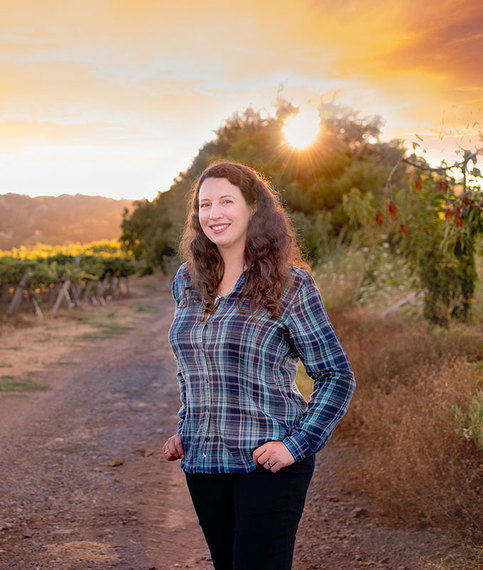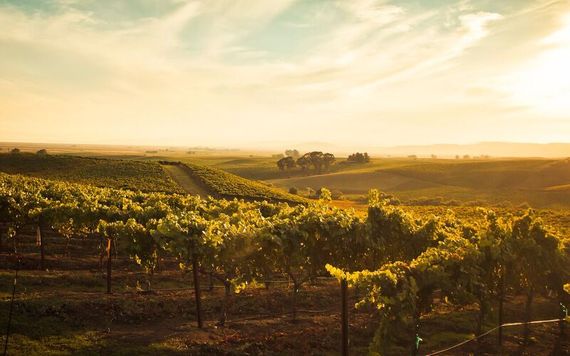I've always believed that Americans tend to like wines whose name they can easily pronounce, like Bolla Soave and Cloudy Bay, and shy away from those they cannot, like Chassagne-Montrachet and Forstmeister Geltz-Zilliken. But that may only begin to describe the allure of the wines of La Crema, whose aficionados have a wide range of wines to choose from under that mellifluous name, including nearly 20 different Pinot Noirs and 10 Chardonnays, along with Pinot Gris and Viognier.
It's become a matter of trust, of course. If a person finds both the La Crema Pinot Noir and Chardonnay to his liking, he is likely to find others in the line intriguing, although prices range from $23 to $90. At dinner at Sea Grill restaurant in New York, I asked La Crema's winemaker, Elizabeth Grant-Douglas (below), why the winery makes so many iterations (that's the wine geek word for different bottlings of the same varietal) of Pinot Noir and Chardonnay.
"La Crema has built a broad reputation for its most popular wines, so people have come to trust the label," she said, "and my job is to maintain a La Crema style in all our wines--not too buttery, not too much oak, letting the fruit shine through--while discovering how our different vineyards can produce nuances."
Thus, a Green Valley Pinot Noir 2013 ($65), which comes from the coolest region of Sonoma, has "firm structure and natural balance;" Shell Ridge Pinot Noir 2012 ($50) is "brilliant, rugged, rich," deriving flavor from the "ancient sea shells in the soils of Shell Ridge;" Chardonnay Nine Barrel 2012 ($70) is "an exceptional expression of a Russian River Valley Chardonnay, made from nine of the highest quality barrels." La Crema also has holdings in other parts of California as well as in Oregon's Willamette Valley.
Grant-Douglas, who grew up in Niagara Falls, Canada, and graduated from Brock University's Cool Climate Oenology and Viticulture program, is expert in dealing with the vagaries of cold terroirs, even making so-called ice wine, whose grapes literally freeze on the vine. She joined La Crema as an enologist in 2001, was named Winemaker in 2010, and since 2013 has been Director of Wine making for the company. "They wanted someone who understood cold climates," she said, "and when I got to La Crema I worked the nigh shift during the harvest as the lowest man on the totem pole. They didn't hire me for my name; I think it was more for my strong back and boundless enthusiasm."
Nor was she hired to make wines that were expressions of her own style. "They didn't hire me to make an `Elizabeth wine' and I wouldn't want to," she said. "Matter of fact, I believe that, if a winemaker makes a Pinot Noir or Chardonnay that shows his hand in it, that's not a good thing. Sometimes you have to wonder how much Pinot Noir is actually in some of those bottles, because they don't taste much like Pinot Noir. They taste more like Zinfandel or Syrah."
One of the ways Grant-Douglas "finalizes" a wine is to take a sample bottle home with her to have with dinner, insisting, "If the wine doesn't go well with food, it's not a good wine."
The winery, which has moved around a bit over four decades, is this summer opening The La Crema Russian River Estate, spread over 260 acres of Saralee's Vineyard. Founded in 1979, later purchased by the Jess Jackson family. Despite the amount of wine La Crema produces, most are made in small-batch appellations of between 2,000 and 6,000 cases.
The treatment of the newly harvested grapes is crucial to achieving a certain delicacy and the creamy texture of La Crema's wines. In the case of Saralee's Vineyard Chardonnay 2013, the grapes "are hand harvested and 100% whole cluster pressed. After one night of cold settling, they are racked in French Open barrels for fermentation, then inoculated with the house strain of malolactic culture and stirred once every three weeks to enhance richness of mouth feel. The juices are racked only once before bottling."
With the Saralee's Vineyard Pinot Noir 2013, "seventy percent whole berries go into open top tank of fermentation, with juice cold-soaked for 3 to 5 days and carefully hand punched three times each day" to achieve the best extraction. The free run wine is then transferred to 100% French oak barrels, where it is aged for 10 months.
The whole aim, as Grant-Douglas says, is to produce a range of wines that are not only exemplary of the varietals in the bottle but that also are definitively La Crema, vintage after vintage, vineyard after vineyard. The less done back at the winery the more likely that is to be achieved.



